FINS
Years before scuba was invented, freedivers and underwater hunters used fins with mask and snorkel to increase their range, get down to depth more quickly, and provide bursts of speed as needed. Fins were created after observing the water-propulsion effectiveness of web-footed animals, such as ducks and frogs. In fact, many early fins were nearly exact copies of a frog’s fins – probably one of the reasons that early military scuba divers were nicknamed “frogmen.”
Fins make swimming with foot-propulsion much easier, much more effective, and considerably more enjoyable. And because scuba divers are not only pushing themselves through the water – they are pushing their gear, as well – fins have been a part of scuba equipment since Day 1. Actually, since almost all of the early scuba divers were freedivers or snorkelers first, fins have been part of scuba since before Day 1.
How Fins Work
If you’ve ever swished your hand through a tub of water (to swirl in some bath salts, for instance), you’ve undoubtedly noticed that water provides resistance to anything moving through it – you can feel the water “pushing back” against your hand.
It’s this push-back that provides much of the propulsion created by a moving fin. Just as the sole of your foot encounters resistance (and thus creates propulsion) when you swim, fins encounter resistance and create propulsion as well. But fins work better than bare feet because their surface area is larger (thus encountering more water for that critical resistance), and – on most modern fins – the undulating motion of the fin provides resistance in both motions of the kick cycle (i.e., the up-motion power stroke as well as the down-motion return stroke, when the fin acts like a scoop being moved through the water).
Physics dictates that the direction of your travel will be the exact opposite of the direction in which you are pushing the water. Because of this, fin manufacturers have paid lots of attention in recent years to channeling – how the fin focuses the direction in which the water is moved. Many manufacturers have also focused on engineering fins that have extremely flexible web sections, split fin construction, and other advantages. All of these are designed to reduce the amount of energy required to move through the less-effective return stroke of a kick cycle, while preserving a great deal of effectiveness on the power stroke.
This results in less muscle fatigue and, (if you are not a regular diver) a decreased chance of post-dive muscle soreness. Divers who are conditioned through regular swimming with fins often claim, though, that less flexible fins, or fins with solid blades, provide greater power in the water. Just which design is the most effective is a source of constant debate among divers and a common topic of post-dive conversation.
One thing is certain, though; swimming with fins is a dramatic and significant improvement over swimming without them.
Which Kind is Best
Determining which fin is best for you begins with determining which sort of diving you’ll be doing most often, and how often you’ll be diving. Free divers and dive professionals who need to be able to cover distance rapidly may opt for fins that are considerably longer than those used by the typical recreational diver. A seasoned and certified wreck diver, or an underwater archaeologist working every day in the confines of a shipwreck, may prefer a shorter fin that would strike many infrequent divers as uncomfortably stiff. Divers who are in the water just about every day will usually want a design that is efficient as possible, even if that makes the fin a little harder to kick. But if you only dive on vacation, you’ll probably want to go the opposite direction and look for ease-of-kicking first – that way your legs are still fresh enough to enter the limbo contest or go dancing in the evening!
Types of Fins
Fins in general are classified as one of two types:
- Full-foot fins (sometimes called “shoe fins”) cover the heel and are donned like a slip-on shoe. Many divers feel close-fitting full-foot fins to be more effective at transferring energy from foot to fin, and traveling divers like the fact that, as full-foot fins are worn over bare feet, there is no need to carry dive boots in the gear bag. These are popular fins among warm-water divers, and they have the added advantage that they are usually lighter weight for traveling.
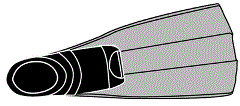
- Open-heel fins are open at the heel and kept on the foot with a heel strap. This type of fin is usually worn with a dive boot. As dive boots come in varying levels of thermal protection, open-heel fins tend to be the popular choice among divers who dive in cold or cooler waters, and among those that demand a fin with greater efficiency, such as professionals. And many people like the fact that, when you remove an open-heel fin, you still have dive boots on. This can make shore entries or crossing rocky beaches considerably more comfortable.
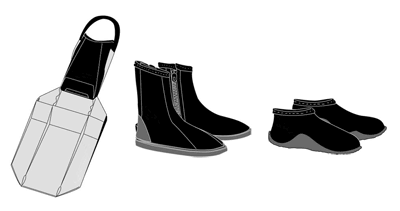
In recent years, a new sub-division has also arisen in both full-foot and open-heel fins:
- Conventional or paddle-bladed fins have a single, undivided blade and are the sort of fin that divers have used for years. Fans of this design say that it is an extremely effective design, because all of the water that contacts the blade gets pushed by it, with none of it “leaking” through. But because this design is so effective, conventional fins can provide significant resistance, and will be harder to kick for those who do not swim with fins regularly.
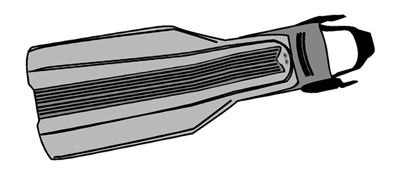
- Split fins have a divide in the “web” of their blade. This can be a short divide on a flared blade (creating a fin that looks much like the fluke of a marine mammal), or a long divide that extends nearly to the foot pocket and separates the blade into two long, stiff strips. Advocates of split fin technology point out that this sort of fin is much easier to kick (especially for the newer or the occasional diver), while still providing significant underwater propulsion.
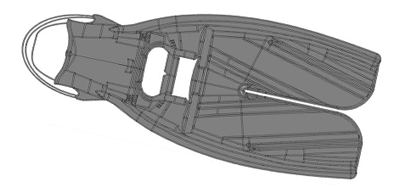
And while all fins may look quite similar at a distance, a number of features will distinguish individual models further:
- Vented fins use vents to allow some water to slip through during the less powerful forward stroke through the water. Vents are one way of making conventional blade designs easier to kick, particularly when swimming against a steady current.
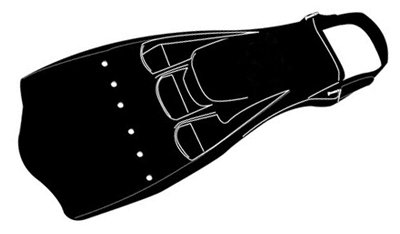
- Energy storing fins use elastic elements to store energy during the return stroke and return it to the kick during the power stroke.
- Removable blades – Some fin designs allow for the removal of the blade from the foot pocket. This makes it easy for the diver to walk out of the water or in shallows without interference by the blade. A variation on this design is the folding blade, which folds upward and allows the diver to walk more easily.
- Spring straps for open-heel fins, once a heavy-duty innovation mainly used by wreck or cave divers, are now gaining popularity among recreational divers because they are virtually unbreakable, they are easy to put on and take off with gloves or mitts on, and they have no tag end that can trap a guideline. Spring straps are heavier than conventional latex or silicone straps, though, as well as being more costly, and they take up a little more packing space.
When & How to Buy
Most divers purchase their first pair of fins before the initial pool session of their open-water dive training, as part of the basic personal gear to be used for the class. But it is not at all unusual for a diver to acquire two or more pairs of fins as time goes on. For instance, if you dive with a wetsuit at some times and a drysuit at others, the boot used with the drysuit will usually require a fin with a wider fin pocket. And for traveling, you may well have a lighter weight fin that packs well and makes traveling easier.
Fins come in sizes, and full-foot fins come in very specific sizes, almost like shoes, so work with your local dive center staff to make sure that you are buying fins that fit you well. Note that a properly fitting set of full-foot fins may be difficult to put on unless your foot is wet, so don’t let ease-of donning influence your purchase of this sort of fin – go by how they feel when you have them on (and rest assured that, when you use them for diving, water will be readily available!).
Likewise, when you buy open-heel fins, you should try to have them fitted to you with the dive boots that you will be wearing. This is a good reason to buy dive boots and fins both at the same time.
As to which fin to get, it’s best to give the professional dive center staff a quick rundown of how experienced a diver you are, how often you dive, and what sort of diving you intend to do with this pair of fins. That will help them to quickly zero in on a selection of fins that will be right to you.
If you are already a certified diver, be aware that dive centers sometimes work with their manufacturers to put on “demo days” when you can try various fin models out in the pool or at a local dive site. Or, if you have a friend with the sort of fins you are considering, and the two of you wear the same size, perhaps you can swap fins for one dive. That’s a great way of finding out if a particular style is right for you (just be sure to buy your friend a post-dive soda as a thank-you).
Fin Maintenance
Fins are remarkably low-maintenance. Rinse them with fresh water after a dive, dry before storing, and you are generally good to go.
It’s important how you store your fins, though. If you store them with the blade canted at an angle, or curved, the blade may take a “set” and retain that new angle for quite some time. To prevent the growth of mold on your fins, always store them dry. Also avoid extremes of temperatures and do not store your fins in sunlight for prolonged periods.
At the beginning of a give season, inspect the straps, blade and channels (the thick, stiffening elements on the sides of your fins) for cracks, and replace the strap or the fins as necessary. If you are using open heeled/adjustable strap fins, consider purchasing a spare set of fin straps to carry with your other equipment, just in case. But rest assured that, for most divers, a good set of fins will provide years of dependable service.